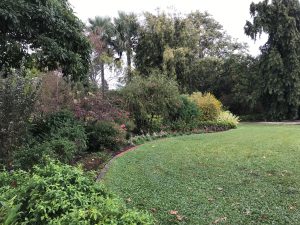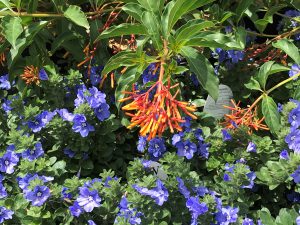Reinventing landscaping
Once upon a time, there was something called Xeriscaping and it was quite the rage. A great idea, it would create a low-maintenance yard that required less water and inputs. The problem was that it wasn’t developed for Florida, but the rocky terrains of Colorado. The idea spread beyond Colorado, but for some, the concept was not clear. Some people even confused the name and called it Zeroscaping. Others thought plantings required cactus and rock gardens. For a Floridian, it just didn’t translate into something they could plug into their yards. Don’t get me wrong, Xeriscaping is still promoted in Colorado and is effective for Colorado’s specialized ecosystem, just not for Florida.

A better way for Florida
The answer for Florida was introduced in 1994 by the University of Florida. It is called Florida-Friendly Landscaping™ (FFL) and the University’s online webpage says it “is the state of Florida’s premier Extension program that promotes sustainable alternatives to “conventional” landscaping, providing guidance on low-impact, environmentally friendly, science-based landscape practices that use less water and reduce pollutant loading to Florida waters”. In short, it is a way for homeowners and communities to enjoy low-maintenance landscaping while protecting Florida’s unique ecosystems and waterways.
Right Plant, Right Place
Florida-Friendly Landscaping™ (FFL) is trademarked by the University of Florida. It is always written as you see it with a hyphen between Florida and Friendly. It is based on 9 principles that all lead to a healthier, easier-maintained yard. Each principle is designed to create a landscape system to which plants thrive while conserving water, fertilizer, and pesticides. The first principle, Right plant, right place is based on the idea that plants thrive in certain environments. A maple tree, for instance, is native to Florida yet in its natural habitat, it grows well in wet organic soils. Sandy soils such as we have on the Lake Wales Ridge are not where maples generally grow well. Although native to Florida, sandy soils would be the wrong place to plant one. Likewise, a plant that is meant to be grown in the shade may not perform well in the sun. Planting the right plant in the right place minimizes the amount of water or fertilizer a plant will need to thrive. Crowding plants could be an example of the right plant in the wrong place. Even when all other conditions are met, plants competing with each other or with the foundation of a home may lead to an unhealthy plant that requires more resources.
Protecting our water

8 more principles follow Right plant, right place. Most of them pertain to keeping our waterways and aquifer clean. Fertilizer, which is so important to the growth of plants, can be a major pollutant. Too much fertilizer and plants like algae thrive in our water systems. Nitrogen and phosphorus are the main culprits and are largely responsible for freshwater algae blooms which can be very toxic to our lakes, streams, and estuaries. The sources of these fertilizers are often from stormwater runoff. Scientists call it non-point source pollution due to not being possible to pinpoint the exact source. Agriculture, septic systems, and of course landscapes are all on the list. Also, since these nutrients are found in the soil, some are carried in stormwater on the way to its final destination. Thursday, April 7th, I will teach a two-hour class at Robbins Nursery South in Sebring that I named a Florida-Friendly Landscaping Talk and Tour. In the first half of the class, I explain the nine principles and issues surrounding managing a healthy ecosystem. In the second half, we will tour about 40 Florida Friendly™ plants and their use in the landscaping. To come to this class we ask you to register in advance by clicking here so we know how many materials we need to bring.
Keep in Touch with UF/IFAS Highlands County
In Highlands County, our office is at 4509 W George Blvd., Sebring. The Master Gardener Help Desk is open Monday – Friday from 9 AM to 3:30 PM.
That’s what’s new from the Hometown Gardener. Like and Follow me on Facebook at Hometown Gardener.
Read my other blogs by clicking here.
Sign up for our Highlands County Master Gardener Volunteer, “Putting Down Root” Newsletter Here.
Join our Facebook groups Highlands County Master Gardeners, Science-Based Florida Gardening Answers, Central Florida Butterfly and Pollinator Club, and Heartland Beekeepers
 1
1
